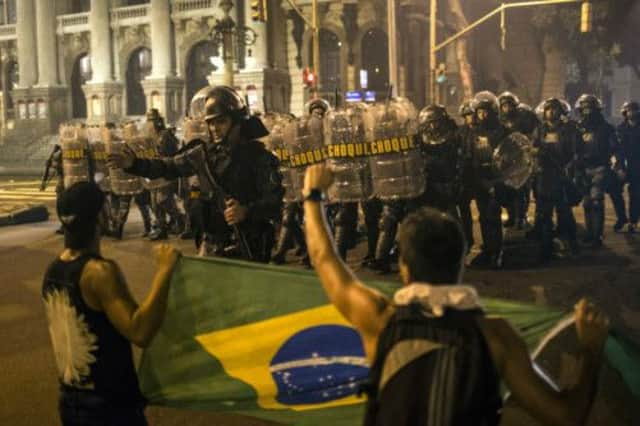Brazil protests: Violent street clashes nationwide


Riot police battled protesters in at least five cities, with some of the most intense clashes in Rio de Janeiro, where an estimated 300,000 demonstrators swarmed into the city’s central area. Television images showed police firing tear gas canisters and rubber bullets into crowds of young men, their faces wrapped in T-shirts. Other demonstrators were shown detained lying on pavements.
In Brasilia, police struggled to keep hundreds of protesters from invading the Foreign Ministry as protesters lit a small fire outside. Other government buildings were attacked around the capital’s central esplanade, and police resorted to tear gas and rubber bullets in attempts to scatter the crowds.
Advertisement
Hide AdAdvertisement
Hide AdClashes were also reported in the Amazon jungle city of Belem, in Porto Alegre in the south, in the university town Campinas, north of Sao Paulo, and in the north-eastern city of Salvador.
The protests took place a week after a violent police crackdown on a much smaller protests in Sao Paulo galvanised Brazilians to take to the streets.
The unrest is hitting the nation as it hosts the Confederations Cup football tournament with tens of thousands of foreign visitors in attendance. It also comes one month before Pope Francis is scheduled to visit the nation, and ahead of the 2014 World Cup and 2016 Olympics, raising concerns about how Brazilian officials will provide security.
Mass protests are rare in this 190 million-person country, with demonstrations generally attracting small numbers of politicised participants. The growing marches have caught Brazilian governments by surprise, but have delighted many citizens.
In Salvador, police shot tear gas canisters and rubber bullets to disperse a small crowd of protesters trying to break through a police barrier blocking one of the city’s streets. One woman was injured in her foot. Elsewhere in Salvador 5,000 protesters gathered in Campo Grand Square.
Despite the energy on the street, many protesters said they were unsure how the movement would win real political concessions. People in the protests have held up signs asking for everything from education reforms to free bus fares while denouncing the billions of public pounds spent on stadiums in advance of the World Cup and the Olympics.
Earlier, people of all ages, many of them draped in flags, gathered in front of the domed Candelaria church in Rio city centre, while groups elsewhere pounded out carnival rhythms or chanted slogans targeting Rio state’s governor.
At one point, a police helicopter flew over the crowd, which booed and pointed green lasers at it.
Advertisement
Hide AdAdvertisement
Hide AdWhen shirtless youths, many of them with T-shirts wrapped round their faces, pushed and jostled their way through the crowd, people spontaneously broke out into a chant of “Without violence!”
But as has been the pattern earlier this week, the clashes began once night fell.
Several city leaders have already accepted protester demands to revoke an increase in bus and subway fares in the hopes that anti-government anger cools. In Sao Paulo, where demonstrators blocked Paulista Avenue, organisers said they would turn their demonstration into a party celebrating the lower transit fares.
But many believe the protests are no longer just about bus fares and have become larger cries for systemic changes.
President Dilma Rousseff is meeting advisers in the heavily guarded presidential palace, according to her press office. Spokesmen did not say whether the president was discussing the protests.